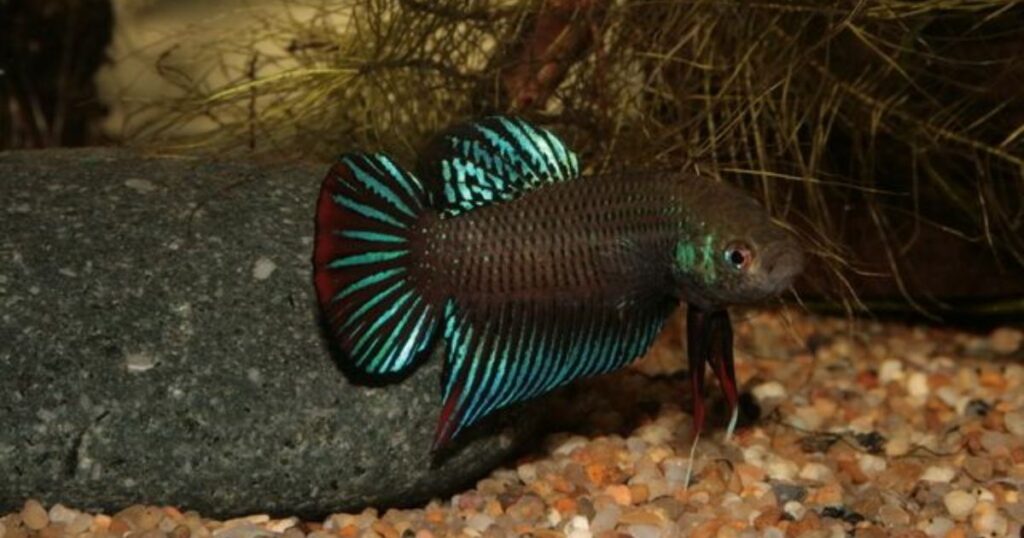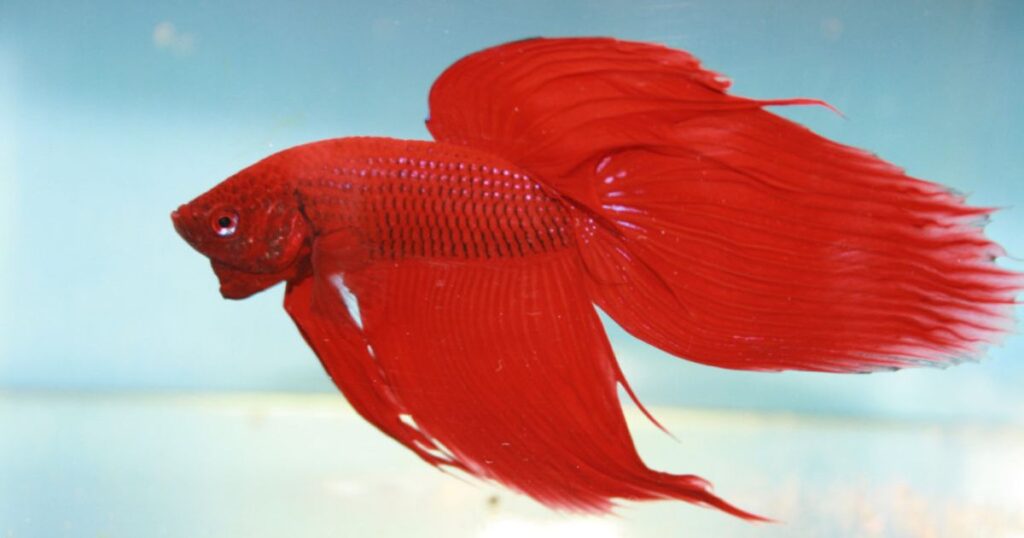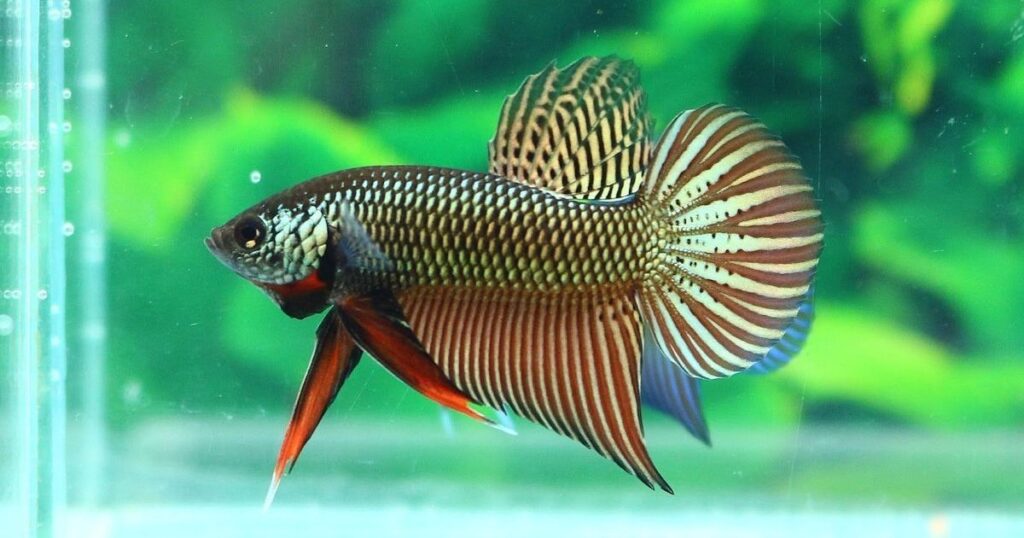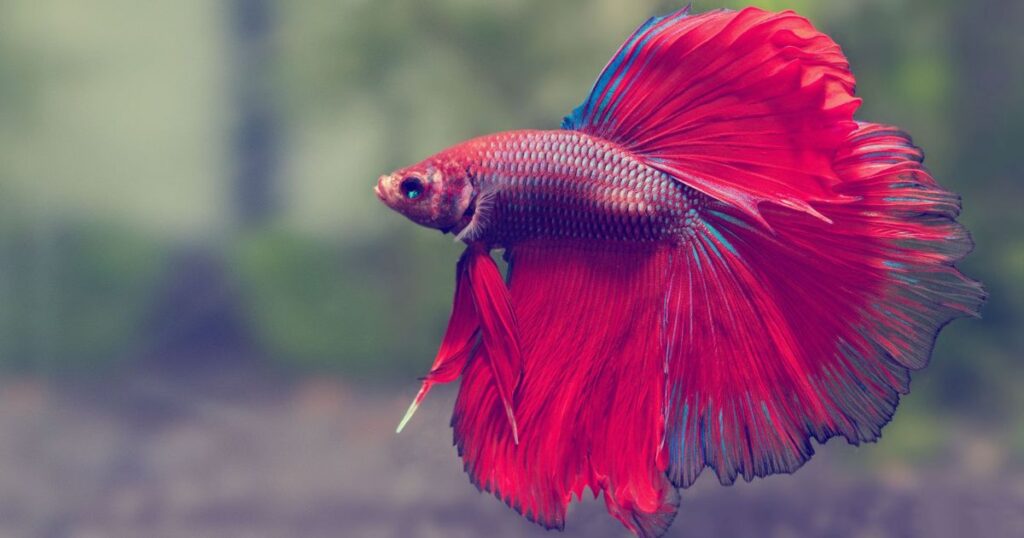If you’ve ever marveled at the mesmerizing colors and flowing fins of the beloved Siamese fighting fish, prepare to be truly captivated by the astounding diversity found among wild betta species.
Often overshadowed by their domesticated counterparts, these natural beauties offer a tantalizing array of unique forms, behaviors, and personalities. They make prime candidates for aquarium enthusiasts seeking something extraordinary.
Wild Betta Species (with pictures)
While the iconic Betta splendens, or Siamese fighting fish, may be the most widely recognized, the betta family boasts a staggering 73 known species – each with its own distinctive charm.
From tiny bubble-nesters to larger, fascinating mouthbrooders, these wild variations present a kaleidoscope of captivating alternatives to the ubiquitous pet store betta.
Here’s a glimpse into the diverse world of wild betta species:
Betta imbellis (Peaceful Betta)

Hailing from Malaysia, this shimmering beauty truly lives up to its ‘peaceful’ name. With a deep green body adorned by a striking red marking on its tail fin, the Betta imbellis is an ideal choice for those new to keeping wild bettas. Their gentle demeanor makes them well-suited for community tanks.
Learn More : Where Do Betta Fish Live In The Wild
Betta Splendens (Siamese Fighting Fish)

This is the original wild species that domestic pet store bettas descended from. It is famous for its bright, bold colors and patterns. The males can also be a bit aggressive and territorial towards each other.
Betta smaragdina (Emerald Betta)

Prepare to be dazzled by this iridescent Thai native. The Betta smaragdina flaunts shimmering green-blue scales complemented by vibrant bursts of red in its fins.
One of the hardiest wild bettas, it’s an excellent option for beginners looking to explore these exotic species.
Betta channoides (Snakehead Betta)

Instantly recognizable by its bold orange-red hues, the Betta channoides is a true standout. Despite its striking appearance, this species is surprisingly peaceful – making it perfect for those interested in a community of wild bettas. Its large size and unique coloration are sure to be the centerpiece of any aquarium.
Other Notable Wild Betta Variations
- Betta macrostoma (Brunei Beauty): This large and powerful betta is a paternal mouthbrooder prized for its distinct, ever-changing patterns and coloration under certain conditions.
- Betta rubra: Found in the peat swamps of Sumatra, this deep crimson wonder will undoubtedly catch your eye. Males are fiercely devoted parents, meticulously protecting eggs and fry.
- Betta stiktos: Despite its tiny size, the Betta stiktos packs a big personality. Their jet-black bodies are adorned with a scattering of iridescent blue spots, and males construct beautiful bubble nests.
- Betta siamorientalis (Blue Betta): Sporting a striking blue body contrasted by a vibrant red gill cover, this relatively peaceful species can sometimes be kept in community settings, making it an intriguing option for the adventurous aquarist.
No matter your experience level, there’s a wild betta species waiting to captivate you with its unique charms.
Embarking on Your Wild Betta Adventure: A Guide
As alluring as these exotic fish may be, it’s crucial to consider several factors before embarking on your wild betta journey:
For Beginners: If you’re new to the world of wild bettas, opt for species from the Betta splendens complex, such as the Betta imbellis or Betta smaragdina. These tend to be more forgiving and better suited for those still learning the ropes.
Mouthbrooder Marvels: Witnessing the fascinating mouthbrooding behavior is a true treat. The manageable size and potential for group living make species like the Betta channoides an excellent entry point into this aspect of wild bettas.
Advanced Beauty: Seasoned aquarists seeking a challenge will find the Betta macrostoma (Brunei Beauty) an irresistible prize. Its ever-changing, dazzling patterns reward those with experience in providing precise care.
Territorial Tendencies: While some wild bettas, particularly those closer to the wild-type Betta splendens, can be territorial, many species are well-suited for community tanks with careful selection of compatible tankmates.
Tank Setup: Different species thrive in varying water parameters and environments. Researching and replicating their natural habitats through appropriate tank setups, plants, and decor is key to their well-being.
No matter which species piques your interest, proper research and preparation are essential for a successful and rewarding wild betta experience.
Caring for a Piece of the Wild

Keeping wild bettas is not only a visually stunning endeavor but also an opportunity to appreciate and conserve these remarkable fish. To foster their health and vibrant beauty, it’s crucial to understand and cater to their specific needs:
Research is Key: Before acquiring any wild betta species, thoroughly research their ideal water conditions, dietary preferences, and behavioral tendencies. Each species is unique, and providing an environment that mimics their natural habitats is paramount.
Nature’s Touch: Recreate their natural environments as closely as possible by incorporating live plants, driftwood, leaf litter, and hiding spots. Maintaining proper water chemistry, including pH, hardness, and temperature, is also essential for their well-being.
Dietary Diversity: In the wild, bettas feast on a variety of foods, including insects, larvae, and even small crustaceans. Offer a balanced diet of high-quality pellets, frozen or live foods to ensure they receive the necessary nutrients.
Temperament Matters: While some wild bettas are relatively peaceful, others can be territorial, particularly during breeding seasons. Consider solitary setups or carefully selected tankmates to avoid potential conflicts.
Conservation Contribution: By responsibly keeping and breeding wild bettas, you not only get to enjoy their beauty but also contribute to the understanding and preservation of these fascinating species in their natural habitats.
Remember, caring for wild bettas is a commitment that requires patience, diligence, and a genuine appreciation for their unique needs. With the right knowledge and preparation, you’ll be rewarded with a mesmerizing piece of the wild in your very own aquarium.
Quotes
Wild bettas are like living jewels – each species dazzles with its own unique beauty and personality. – Experienced Betta Breeder
Keeping wild bettas isn’t just about having an exotic fish; it’s about connecting with and preserving a piece of nature’s wonders. – Aquarium Enthusiast
Case Study: Successful Wild Betta Community Tank
Tank Size: 30 gallons Inhabitants:
- 1 male Betta channoides
- 6 Celestial Pearl Danios
- 10 Neon Tetras
- 5 Otocinclus Catfish
- 2 Amano Shrimp
Key Factors:
- Heavily planted with driftwood and leaf litter
- Soft, acidic water (pH 6.5, hardness 2-4 dGH)
- Weekly water changes (25-30%)
- Varied diet of pellets, frozen foods, and occasional live foods
This thriving community showcases the peaceful nature of the Betta channoides when provided with ample hiding spots, suitable water conditions, and appropriate tankmates.
With careful planning and maintenance, wild bettas like these can coexist harmoniously in a captivating display of biodiversity.
Bold Terms
- Mouthbrooders: Certain betta species exhibit a unique parental care method where the male carries the fertilized eggs and fry in his mouth until they’re ready to venture out.
- Bubble Nests: Many betta males construct intricate nests made of bubbles at the water’s surface, where they deposit and care for their eggs.
- Paternal Care: Unlike many other fish, male bettas play an active role in caring for and protecting their offspring.
- Iridescence: The stunning, rainbow-like shimmer displayed by many wild betta species, particularly pronounced under certain lighting conditions.
Conclusion
Wild betta species offer a diverse kaleidoscope of colors, patterns, and personalities beyond the common Siamese fighting fish. From tiny bubble-nesters to larger mouthbrooders, these natural gems captivate aquarium hobbyists.
With proper research and environment replication, you can responsibly enjoy and help conserve these incredible fish. Unveil the fascinating realm of wild bettas in your home aquarium for an endlessly rewarding journey.
FAQs
What is a wild type betta?
Wild bettas are less well-known and live naturally in the wild. Many people think wild bettas are hard to care for, but they are similar to other fish you can buy at the local pet store.
How to identify wild betta?
To identify wild bettas, look for elongated bodies, less vibrant colors, and the presence of horizontal stripes or spots. Their fins are usually shorter and less ornate compared to domesticated varieties.
What is the prettiest wild betta fish?
The Betta Imbellis, also known as the peaceful betta or the crescent betta, is native to South East Asia. The specie is one of the most popular wild betta fish in the fishkeeping hobby. Betta imbellis pair. HABITAT The species is found in swamp waters, ditches, rice paddies, and pools.
Are wild type bettas aggressive?
You should bear in mind that the aquarium bettas you’re familiar with have been artificially bred to be more colorful and aggressive than the wild ones. Those in nature aren’t nearly as much so. Wild bettas are usually brown, gray, and green and have much shorter fins than the aquarium-bred ones.







